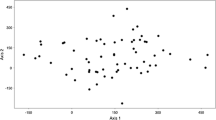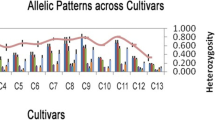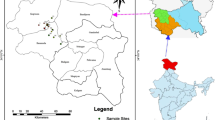Abstract
Citrus plants are one of the most important fruit plants which are consumed all over the world. The breeding of these valuable fruit plants is based on selection of elite genotypes and grafting. Large number of fruit trees with different local names and labels are available in the country, but very limited knowledge is in hand on their genetic content and their relationship. The present study was conducted on 15 sweet orange populations of Iran, with the aim to produce data on their genetic structure, diversity and affinity by using IRAP molecular markers. The studied cultivars produce 24 IRAP loci or bands. In total each cultivar studied contained 5–16 IRAP bands with no private/specific bands formation. Genetic diversity parameters determined revealed that genetic polymorphism vary from 0 in to 45% in the studied sweet orange trees. Discriminating power of IRAP loci was determined by multivariate canonical correspondence analysis. Analysis of molecular variance (AMOVA) revealed significant genetic difference among these cultivars, and pair-wise AMOVA identified those sweet oranges which differed genetically from each other. Unweighted pair group method with arithmetic mean dendrogram of the studied samples grouped these cultivars and their replicates in four distinct clusters, which was also supported by discriminate analysis of principal components plot. Therefore, cultivars which are genetically similar and labeled differently were identified and genetic affinity of the cultivars are discussed. These findings will be used in future sweet orange conservation and breeding.





Similar content being viewed by others
Data availability
All data are available from the corresponding author on reasonable request.
Code availability
None.
References
Abdi H, Williams LJ (2010) Principal component analysis. Wiley, Chichester, pp 433–59
Aydin U, Turgut Y (2012) Genetic diversity in citrus. Genetic Diversity in Plants, pp 213–230
Ben Abdelaali S, Saddoud O, Abdelaali NB, Hajlaoui MR, Mars M (2018) Fingerprinting of on-farm conserved local tunisian orange cultivars (Citrus sinensis (L.) osbeck) using microsatellite markers. Acta Biol Cracov Bot 60:83–93
Ben-Abdelaali S, Rodrigo MJ, Saddoud O, Zacarías L, Hajlaouib MR, Mars M (2018) Carotenoids and colour diversity of traditional and emerging Tunisian orange cultivars (Citrus sinensis (L.) Osbeck). Sci Hortic 227: 296–304
Collard BCY, Mackill DJ (2009) Start codon targeted (SCoT) polymorphism: a simple novel DNA marker technique for generating gene-targeted markers in plants plant. Mol Biol Rep 27:86
Debbabi OS, Mezghani N, Madini M, Abedelaali NB, Bouhlel R, Ksia A, Mars M (2014) Genetic diversity of orange fruit (Citrus sinensis L.) cultivars in Tunisia using AFLP markers. IJAAR 5(1):7–15
Fang DQ, Roose ML (1997) Identification of closely related citrus cultivars with inter-simple sequence repeat markers. Theor Appl Genet 95: 408–417
Golein B, Talaie A, Zamani Z, Ebadi A, Behjatnia A (2005) Assessment of genetic variability in some Iranian sweet oranges (Citrus sinensis (L.) Osbeck) and Mandarins (Citrus reticulata Blanco) using SSR markers. 7: 167–170
Hamer ØM, Harper DAT, Ryan PD (2012) PAST: paleontological statistics software package for education and data analysis. Palaeontol Elec 4:9
Hvarleva T, Kapari-Isaia T, Papayiannis L, Atanassov A, Had**icoli A, Kyriakou A (2008) Characterization of Citrus cultivars and clones in Cyprus through microsatellite and RAPD analysis. Biotechnol Biotechnol Eq 22:787–794
Jannati M, Fotouhi Ghazvini R, Abad A, Zivar S (2009) Genetic diversity analysis of Iranian Citrus varieties using micro satellite (SSR) based markers. J Hortic for 1:120–125
Kalendar RT, Grob M, Regina A, Suoniemi A, Schulman (1999) IRAP and REMAP: two new retrotransposon-based DNA fingerprinting techniques. Theor Appl Genet 98:704–711
Krisman M, Jakše J, Barièeviè D, Javornik B, Prošek M (2006) Robust CTAB-activated charcoal protocol for plant DNA extraction. Acta Agric Slov 87:427–433
Lame Juibary P, Seyed mehdi FS, Sheidai M, Noormohammadi Z (2021) Genetic structure analysis and genetic finger printing of sweet orange cultivars (Citrus sinensis (L.) Osbeck) by using SCoT molecular markers. Genet Resour Crop Evol 68:1645–1654
Lamine M, Chebaane A, Mliki A (2015) Genetic diversity analysis in Tunisian Maltaise orange (Citrus sinensis L.). J New Sci 14(2): 438–448
Novelli VM, Cristofani M, Souza AA, Machado MA (2006) Development and characterization of polymorphic microsatellite markers for the sweet orange (Citrus sinensis L. Osbeck). Genet Mol Biol 29:90–96
Peakall R, Smouse PE (2006) GENALEX 6: genetic analysis in Excel Population genetic software for teaching and research. Mol Ecol Not 6:288–295
Penjor T, Yamamoto M, Uehara M, Ide M, Matsumoto N, Matsumoto R, Nagano Y (2013) Phylogenetic relationships of Citrus and its relatives based on matK gene sequences. PLoS ONE 8(4):62574
Podani J (2000) Introduction to the exploration of multivariate data, Leide
Rao VR, Hodgkin T (2002) Genetic diversity and conservation and utilization of plant genetic resources. Plant Cell Tiss Org 68:1–19
Weising K, Nybom H, Wolff K, Kahl G (2005) DNA fingerprinting in plants. In: Principles, methods, and applications. Boca Rayton: CRC Press
Funding
None.
Author information
Authors and Affiliations
Contributions
MS: conceptualization of the project; FZ: data collection and lab work.
Corresponding authors
Ethics declarations
Conflict of interest
All authors have no conflict of interest.
Data archiving statement
In Shahid beheshti university.
Additional information
Publisher's Note
Springer Nature remains neutral with regard to jurisdictional claims in published maps and institutional affiliations.
Rights and permissions
About this article
Cite this article
Zanganeh, F., Sheidai, M. Population genetic diversity and genetic affinity analyses of sweet orange cultivars (Citrus sinensis (L.) Osbeck) by using IRAP molecular markers. Genet Resour Crop Evol 69, 2437–2446 (2022). https://doi.org/10.1007/s10722-022-01382-x
Received:
Accepted:
Published:
Issue Date:
DOI: https://doi.org/10.1007/s10722-022-01382-x




